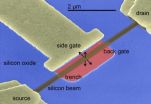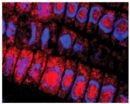(Press-News.org) DURHAM, N.C. -- By measuring the unique properties of light on the scale of a single atom, researchers from Duke University and Imperial College, London, believe that they have characterized the limits of metal's ability in devices that enhance light.
This field is known as plasmonics because scientists are trying to take advantage of plasmons, electrons that have been "excited" by light in a phenomenon that produces electromagnetic field enhancement. The enhancement achieved by metals at the nanoscale is significantly higher than that achievable with any other material.
Until now, researchers have been unable to quantify plasmonic interactions at very small sizes, and thus have been unable to quantify the practical limitations of light enhancement. This new knowledge gives them a roadmap for precisely controlling light scattering that should help in the development of devices, such as medical sensors and integrated photonic communications components.
Typically, plasmonic devices involve the interactions of electrons between two metal particles separated by a very short distance. For the past 40 years, scientists have been trying to figure out what happens when these particles are brought closer and closer, at sub-nanometer distances.
"We were able to demonstrate the accuracy of our model by studying the optical scattering from gold nanoparticles interacting with a gold film," said Cristian Ciracì, postdoctoral researcher at Duke's Pratt School of Engineering. "Our results provide a strong experimental support in setting an upper limit to the maximum field enhancement achievable with plasmonic systems."
The results of the experiments, which were conducted in the laboratory of David R. Smith, William Bevan Professor of electrical and computer engineering at Duke, appear on the cover of Science, Aug. 31, 2012.
Ciracì and his team started with a thin gold film coated with an ultra-thin monolayer of organic molecules, studded with precisely controllable carbon chains. Nanometric gold spheres were dispersed on top of the monolayer. Essential to the experiment was that the distance between the spheres and the film could be adjusted with a precision of a single atom. In this fashion, the researchers were able to overcome the limitations of traditional approaches and obtain a photonic signature with atom-level resolution.
"Once you know maximum field enhancement, you can then figure out the efficiencies of any plasmonic system," Smith said. "It also allows us to 'tune' the plasmonic system to get exact predictable enhancements, now that we know what is happening at the atomic level. Control over this phenomenon has deep ramifications for nonlinear and quantum optics."
The Duke team worked with colleagues at Imperial College, specifically Sir John Pendry, who has long collaborated with Smith.
"This paper takes experiment beyond nano and explores the science of light on a scale of a few tenths of a nanometer, the diameter of a typical atom," said Pendry, physicist and co-director of the Centre for Plasmonics and Metamaterials at Imperial College. "We hope to exploit this advance to enable photons, normally a few hundred nanometers in size, to interact intensely with atoms which are a thousand times smaller."
INFORMATION:
The research was supported by the Air Force Office of Scientific Research and by the Army Research Office's Multidisciplinary University Research Initiative (MURI).
The other members of the team were Duke's Ryan Hill, Jack Mock, Yaroslav Urzhumov and Ashutosh Chilkoti; and from Imperial College, Antonio Fernández-Domínguez and Stefan Maier.
Researchers measure photonic interactions at the atomic level
2012-08-31
ELSE PRESS RELEASES FROM THIS DATE:
'Nanoresonators' might improve cell phone performance
2012-08-31
"There is not enough radio spectrum to account for everybody's handheld portable device," said Jeffrey Rhoads, an associate professor of mechanical engineering at Purdue University.
The overcrowding results in dropped calls, busy signals, degraded call quality and slower downloads. To counter the problem, industry is trying to build systems that operate with more sharply defined channels so that more of them can fit within the available bandwidth.
"To do that you need more precise filters for cell phones and other radio devices, systems that reject noise and allow signals ...
Discovery may help protect crops from stressors
2012-08-31
VIDEO:
Scientists at the Salk Institute for Biological Studies have discovered a key genetic switch by which plants control their response to ethylene gas, a natural plant hormone best known for...
Click here for more information.
LA JOLLA, CA----Scientists at the Salk Institute for Biological Studies have discovered a key genetic switch by which plants control their response to ethylene gas, a natural plant hormone best known for its ability to ripen fruit, but which, under ...
Biophysicists unravel secrets of genetic switch
2012-08-31
When an invading bacterium or virus starts rummaging through the contents of a cell nucleus, using proteins like tiny hands to rearrange the host's DNA strands, it can alter the host's biological course. The invading proteins use specific binding, firmly grabbing onto particular sequences of DNA, to bend, kink and twist the DNA strands. The invaders also use non-specific binding to grasp any part of a DNA strand, but these seemingly random bonds are weak.
Emory University biophysicists have experimentally demonstrated, for the fist time, how the nonspecific binding of ...
NASA spotted hot towers in Ileana that indicated its increase to hurricane status
2012-08-31
Hot Towers are towering clouds that emit a tremendous amount of latent heat (thus, called "hot"). NASA research indicates that whenever a hot tower is spotted, a tropical cyclone will likely intensify. Less than 14 hours after the TRMM satellite captured an image of Ileana's rainfall and cloud heights, Ileana strengthened into a hurricane on Aug. 29.
NASA's Tropical Rainfall Measuring Mission (TRMM) satellite captured a view of Ileana's rainfall rates on Aug. 29 at 2:17 a.m. EDT and saw the heaviest rainfall rates, near 50 mm (2.0 inches) per hour in a band of thunderstorms ...
NASA sees Tropical Storm Tembin make landfall in South Korea
2012-08-31
Tropical Storm Tembin made landfall in the in southwestern South Korea and NASA's Aqua satellite captured the extent of the storm's elongated cloud cover, revealing the effect of wind shear on the storm.
Tembin moved through the Myeongnyang Strait and made landfall on Aug. 30, 2012 at 0000 UTC (Aug. 29 at 8 p.m. EDT) in the southwestern tip of South Korea.
NASA's Aqua satellite's Moderate Resolution Imaging Spectroradiometer (MODIS) instrument captured a visible, true-color image of Tropical Storm Tembin around the time of landfall in southwestern South Korea. The image ...
NASA spies fifth Atlantic hurricane and twelfth tropical depression
2012-08-31
Tropical Storm Kirk intensified into a hurricane today, Aug. 30, while another tropical depression was born. Satellite imagery revealed Hurricane Kirk and newborn Tropical Depression 12 romping through the central Atlantic Ocean today, while Tropical Storm Isaac continues to drench the U.S. Gulf coast and Mississippi Valley. Kirk became the Atlantic Ocean season's fifth hurricane today, Aug. 30.
On Aug. 30 at 7:45 a.m. EDT, a visible image from NOAA's GOES-13 satellite captured all three tropical cyclones in a panoramic shot of the Atlantic Ocean basin. The visible image ...
Rice, MD Anderson scientists probe mystery of operon evolution
2012-08-31
HOUSTON -- (Aug. 30, 2012) -- The threads of an evolutionary mystery that dates to the birth of molecular biology are beginning to unravel, thanks to a new investigation by computational bioengineers at Rice University and the University of Texas MD Anderson Cancer Center.
In new research published online this week in PLOS Computational Biology, Rice's Oleg Igoshin and MD Anderson's Christian Ray offer a possible explanation for the existence of jointly controlled clusters of genes called operons, which are found in bacterial chromosomes but not in those of higher order ...
Traumatic childhood may increase the risk of drug addiction
2012-08-31
Previous research has shown that personality traits such as impulsivity or compulsiveness are indicators of an increased risk of addiction. Now, new research from the University of Cambridge suggests that these impulsive and compulsive personality traits are also associated with a traumatic upbringing during childhood. The study was published today, 31 August, in the journal American Journal Psychiatry.
Led by Dr Karen Ersche, the Cambridge researchers aimed to identify risk factors that make a person vulnerable to developing drug dependence. They examined 50 adults ...
Lilburn, GA Accident Injury Chiropractor Helps Locals Get Relief from Whiplash Pain
2012-08-31
Dr. Matthew Loop, whose busy chiropractic office is located in Lilburn GA, uses a combination of approaches to help relieve the discomfort and stress associated with back pain. His approach includes chiropractic, soft tissue therapy and rehabilitation services. This combination offers patients quick relief.
"The problem with auto injuries," says Dr. Loop, "is that they can manifest themselves in so many different ways, making pain management for the patient very difficult. Some patients suffer from generalized pain that is combined with pain located in ...
The Art of Living Foundation Announces The Launch Of Take A Breath, Seattle! An Initiative to Recharge People in Seattle
2012-08-31
The Art of Living Foundation announced today that it has launched Take a Breath, Seattle, an initiative to help Seattleites recharge and do more of the things they love through the powerful benefits of breath.
Take a Breath, Seattle, is an ambitious initiative that aims to increase awareness about the powerful benefits of breath as a practical tool to combat stress.
The Seattle metro continues to be home for an active, health-conscious population - many of who work under high pressure to deliver in an intensely competitive environment, often leaving them stressed ...






